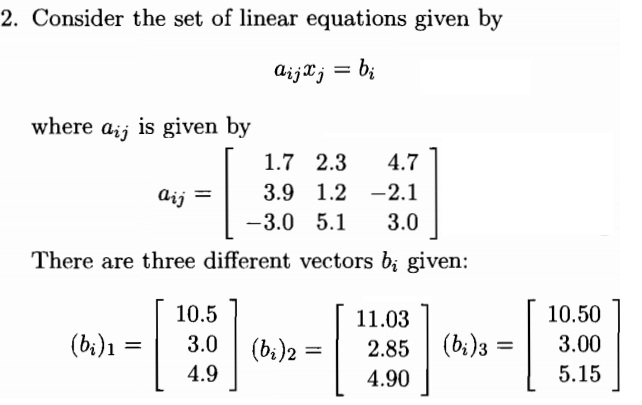Problems:
1. Solve the following set of linear algebraic equations using Gaussian elimination.
12x - 8.6y = 52.16
5.3x + 17y = 114.55
Carry at least 7 figures in your calculations. State whether or not you think this system is highly sensitive to small changes in the right-hand sides. On what did you base your opinion?

There are three different vectors bi given:
(a) Solve these equations using Gaussian elimination, including all three vectors bi in your solution. To fascilitate your calculations you may write the coefficient matrix together with all three known vectors bi and a column containing the sum of all numbers in each row:
The checksum column provides you a check on your calculations. At any step in the Gaussian elimination process should the last element of each row equalthe sum of all other elements: checksum.
Also rearrange the equations to put the largest elements on the diagonal, as far as possible (partial pivoting). Comment on the sensitivity of the solution to 10% changes in the known vector
(b) Check your results by substituting back into the original equations.
3. For dietary statistics, various international agencies define (anachronistically) the "standard human" to be a 70 kg male. This standard man is estimated to need 70 g of protein each day in his food. Suppose a combination of soybeans and lentils is available to supply the protein requirement. Soybeans contain 35% protein and lentils 26%, on a weight: weight basis.
Derive a general equation representing all combinations of S (grams of soybeans) and L (grams of lentils) that would exactly meet the 70 g protein requirement. If a man consumes 50 g of soybeans, how many grams of lentils would he need that day?
4. A large Midwestern power plant burns a mixture of high-sulfur Indiana coal (4% sul¬fur by weight) and low-sulfur Wyoming coal (1.5% sulfur by weight). The western anthracite has higher energy content (W = 2500 BTU /ton) than the Indiana bitu¬minous coal (I = 2100 BTU /ton). Note: these numerical values are rough estimates, but will suffice for the purpose of this exercise.
For each 100,000 BTU produced, the plant is to emit no more than 1 ton of sulfur. Unfortunately, because the western coal is considerably more expensive than the Midwestern, the plant manager chooses to emit that full amount. How many tons of each type of coal should the plant burn for each 100,000 BTU of thermal energy? Use both Gauss elimination and Gauss-Seidel to solve this problem. You may "code" the Gauss-Seidel iterations on a calculator or computer or do 3 iterations by hand. Provide units for all quantities.